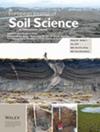Mapping of Acid Sulfate Soil Types in Laihianjoki River Catchment: A Multiclass Classification
IF 3.8
2区 农林科学
Q2 SOIL SCIENCE
引用次数: 0
Abstract
Mapping of acid sulfate soils (ASS) has in the past focused mainly on ASS probability maps, which are very useful to avoid environmental damage caused by these soils. However, these maps do not indicate the ASS subtypes, which may have different environmental impacts depending on whether they are actively releasing acidity and metals (sulfuric soils) or have the potential to do so (hypersulfidic soils) if the sulfidic material within them is disturbed (oxidized). Additionally, there is a particular type of soil that is close to being classified as an ASS, but where the pH criterion is not fulfilled. This soil is referred to as para‐ASS and may have a similar negative environmental impact as ASS. In the risk assessment of ASS, it is therefore crucial to know the location of ASS subtypes as well as para‐ASS. In this study, we have created for the first time a multiclass map of ASS subtypes in Finland. Furthermore, four probability maps have been generated, one for each class. For this, the suitability of two machine learning methods for multiclass classification of different ASS subtypes has been evaluated. The methods are random forest (RF) and gradient boosting (GB), which showed very high capabilities for the classification of ASS in binary classification. RF has given the best results with莱希安约基河流域硫酸土壤类型的多类分类
以往的硫酸酸性土壤制图主要集中在硫酸酸性土壤的概率图上,这对于避免硫酸酸性土壤对环境造成的破坏是非常有用的。然而,这些地图并没有显示ASS亚型,这些亚型可能会产生不同的环境影响,这取决于它们是主动释放酸性和金属(含硫土壤),还是有可能这样做(高硫化物土壤),如果其中的硫化物物质受到干扰(氧化)。此外,有一种特殊类型的土壤接近被归类为有害土壤,但其pH值不符合标准。这种土壤被称为para - ASS,可能具有与ASS相似的负面环境影响。因此,在ASS风险评估中,了解ASS亚型和para - ASS的位置至关重要。在这项研究中,我们首次在芬兰创建了ASS亚型的多类地图。此外,还生成了四个概率图,每个类一个。为此,评估了两种机器学习方法对不同ASS亚型的多类分类的适用性。随机森林(random forest, RF)和梯度增强(gradient boosting, GB)两种方法在二值分类中表现出很高的分类能力。RF给出了四个类别的最佳结果,F1得分值在71%到80%之间。使用RF模型创建了准确而真实的ASS亚型多类图。
本文章由计算机程序翻译,如有差异,请以英文原文为准。
求助全文
约1分钟内获得全文
求助全文
来源期刊

European Journal of Soil Science
农林科学-土壤科学
CiteScore
8.20
自引率
4.80%
发文量
117
审稿时长
5 months
期刊介绍:
The EJSS is an international journal that publishes outstanding papers in soil science that advance the theoretical and mechanistic understanding of physical, chemical and biological processes and their interactions in soils acting from molecular to continental scales in natural and managed environments.
 求助内容:
求助内容: 应助结果提醒方式:
应助结果提醒方式:


